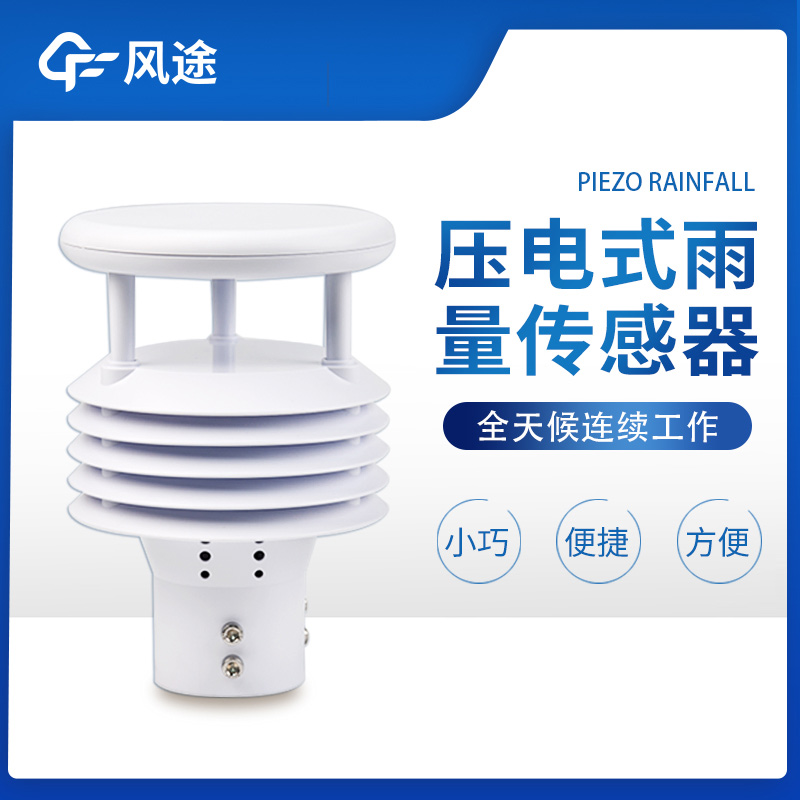Tianqiong Sensor IOT Technology Co., Ltd
Sales Manager:Ms. Emily Wang
Cel,Whatsapp,Wechat:+86 15898932201
Email:info@fengtutec.com
Add:No. 155 Optoelectronic Industry Accelerator, Gaoxin District, Weifang, Shandong, China

Sales Manager:Ms. Emily Wang
Cel,Whatsapp,Wechat:+86 15898932201
Email:info@fengtutec.com
Add:No. 155 Optoelectronic Industry Accelerator, Gaoxin District, Weifang, Shandong, China
time:2025-05-14 09:42:52 source:Weather Station viewed:200 time
In the fields of meteorological monitoring and hydrology, the piezoelectric rain gauge and the Radar Precipitation Sensor Rain Gauge Distrometer are commonly used rainfall monitoring devices. Today, the author will compare the differences between the two.
The piezoelectric rain gauge works by utilizing the piezoelectric effect. When raindrops strike the surface of the sensor, they cause pressure changes, which are then converted into electrical signals to calculate the amount of rainfall. It has a fast response speed and can promptly capture changes in rainfall, providing rapid feedback even for slight changes in rainfall. It is simple and convenient to install, and has no strict requirements for the installation environment. It can be installed by a single person within a short period of time. It has a low maintenance cost, as there are no complex moving parts inside, reducing the risk of malfunctions and the frequency of maintenance. Moreover, it has a relatively high measurement accuracy and can accurately record the amount of rainfall. However, during heavy rainfall, the rapid impact of a large number of raindrops may cause the sensor to saturate, leading to measurement errors. It is also sensitive to environmental interference, such as vibrations caused by strong winds or external objects touching it, which can easily result in data deviations.
The Radar Precipitation Sensor Rain Gauge Distrometer uses 24GHz Doppler radar wave technology. By measuring the falling speed and particle size of precipitation droplets, it can distinguish between different types of precipitation such as rain, snow, and hail, as well as the intensity of rainfall. It can achieve large-scale monitoring, covering a large area and obtaining the overall precipitation situation within the region. It has a high recognition accuracy for various types of precipitation. Whether it is a light drizzle or a heavy rain, it can accurately measure parameters such as rainfall intensity. However, the Radar Precipitation Sensor Rain Gauge Distrometer is expensive, with a high procurement cost. The installation and calibration processes are complex and require professional personnel and specialized equipment to operate to ensure measurement accuracy. It is greatly affected by the terrain and obstacles. For example, the presence of high mountains, tall buildings, etc. around it will interfere with the propagation of radar waves, causing deviations in the measurement data.
Based on the above characteristics, the piezoelectric rain gauge is suitable for scenarios with high requirements for monitoring local rainfall changes and the need for rapid response. For example, at urban waterlogging monitoring points, it can promptly detect sudden changes in rainfall amounts, providing a basis for drainage scheduling. In field scientific research monitoring stations, the advantages of its simple installation and maintenance can be fully utilized. The Radar Precipitation Sensor Rain Gauge Distrometer is more suitable for meteorological departments to conduct regional weather forecasting, as it can provide large-scale precipitation data. In large-scale water conservancy hub projects, it can comprehensively grasp the precipitation situation in the basin, facilitating flood early warning and water conservancy scheduling.

A Portable Weather Station is a movable on-site observation device. It has the advantages of portability, easy operation and accurate measurement, and can integrate monitoring functions for multiple meteorological elements to meet various dynamic observation needs. It can conduct all-weather and uni...
Due to the special nature of their production processes, chemical plants have strict requirements for meteorological condition monitoring. This need stems from two core backgrounds: first, from a safety perspective, many chemical materials are extremely sensitive to wind speed, wind direction, and o...
The Ultrasonic Wind Speed Direction Sensor achieves measurement based on the characteristics of ultrasonic waves propagating in the air. It accurately calculates the wind speed and direction by measuring the time difference of ultrasonic waves propagating in different directions. This non-mechanical...
Our self-developed Portable Weather Station breaks through the scenario limitations of traditional meteorological equipment. With multi-dimensional monitoring capabilities and high-precision performance, it has become the preferred equipment for various mobile monitoring scenarios.The device can sim...